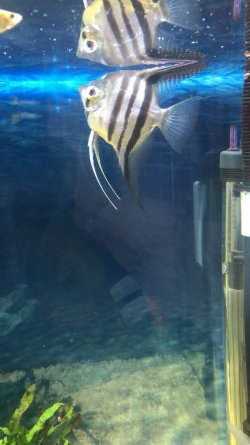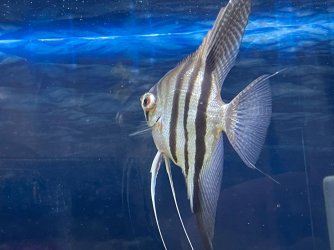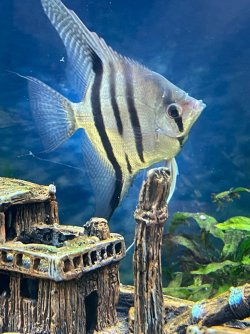asifd
New Member
Hi - please help,
My son yesterday evening noticed that our silver angel fish had one eye bulging out. He is usually very healthy, eats well and had no problems in the past. Looking through the other post online, my initial guess is it is pop eye due to injury but comparing it to other photos, i'm not so sure now.
Other fish in tank are: one other angelfish - orange - no fighting between these two - possibly same sex - female
five Stendkar discus - various sizes (2 small, 2 medium, 1 large)
one betta
one zebra danio
5 five banded barbs
2 corydors
4 guppies
temp : 29 C (only just increased last week from 28 C - explanation below)
180L tank, gravel substrate, few ornaments, external cannister filter fluval, LED lights, 3 plants but not growing well. Tank established Jan 2021. Perform 50-60% water change weekly on fridays and clean filters beginning of every month. UV lamp via filter runs 2 hours per day. Last new fish to be added were guppies about 2 months ago.
Ammonia - 0
Nitrite - 0
Nitrate - 40ppm (my tap water comes out with this much nitrate)
pH 7.6 - 7.8
Fish are fed twice a day with Stendkar brand beefheart and Sera growth granules.
Just last week, I lost one discus and one male orange angelfish. The discus had white pimple like spots on the top of the head near the eyes. Treated with melafix and it went for a few days but returned. Kept treatment ongoing for another week but discus died. Initially thought it may have been an injury or something and the white spot like pimples were like scabs. 100% sure it was not ich because it was localised in one area and the spots were big. This discus also went off his food during this time. Now, I am thinking possibly hexamita. Poop was not stringy but not sure if brown or white in colour.
The male orange angelfish had an injury on its side (this angelfish was always very territorial so frequently in fights). Happened same time as discus getting white spots so treated with melafix. The injury got better but this angelfish was breathing heavily and went off its food. Assumed possibly gill flukes so treated with flubendazole and increased aeration but never recovered and eventually died.
Please help with my silver angelfish. Last night, I added one tablespoon of API salt for every 20 L of water (ie 9 tablespoons for 180L). I am based in the UK so cannot buy antibiotics from LFS but I do have access to human antibiotics if that is only cure.
I have not set up a hospital / QT tank because in the past, I always get an ammonia spike and get forced to move the fish into the main tank. Thank you in advance to all who reply.
My son yesterday evening noticed that our silver angel fish had one eye bulging out. He is usually very healthy, eats well and had no problems in the past. Looking through the other post online, my initial guess is it is pop eye due to injury but comparing it to other photos, i'm not so sure now.
Other fish in tank are: one other angelfish - orange - no fighting between these two - possibly same sex - female
five Stendkar discus - various sizes (2 small, 2 medium, 1 large)
one betta
one zebra danio
5 five banded barbs
2 corydors
4 guppies
temp : 29 C (only just increased last week from 28 C - explanation below)
180L tank, gravel substrate, few ornaments, external cannister filter fluval, LED lights, 3 plants but not growing well. Tank established Jan 2021. Perform 50-60% water change weekly on fridays and clean filters beginning of every month. UV lamp via filter runs 2 hours per day. Last new fish to be added were guppies about 2 months ago.
Ammonia - 0
Nitrite - 0
Nitrate - 40ppm (my tap water comes out with this much nitrate)
pH 7.6 - 7.8
Fish are fed twice a day with Stendkar brand beefheart and Sera growth granules.
Just last week, I lost one discus and one male orange angelfish. The discus had white pimple like spots on the top of the head near the eyes. Treated with melafix and it went for a few days but returned. Kept treatment ongoing for another week but discus died. Initially thought it may have been an injury or something and the white spot like pimples were like scabs. 100% sure it was not ich because it was localised in one area and the spots were big. This discus also went off his food during this time. Now, I am thinking possibly hexamita. Poop was not stringy but not sure if brown or white in colour.
The male orange angelfish had an injury on its side (this angelfish was always very territorial so frequently in fights). Happened same time as discus getting white spots so treated with melafix. The injury got better but this angelfish was breathing heavily and went off its food. Assumed possibly gill flukes so treated with flubendazole and increased aeration but never recovered and eventually died.
Please help with my silver angelfish. Last night, I added one tablespoon of API salt for every 20 L of water (ie 9 tablespoons for 180L). I am based in the UK so cannot buy antibiotics from LFS but I do have access to human antibiotics if that is only cure.
I have not set up a hospital / QT tank because in the past, I always get an ammonia spike and get forced to move the fish into the main tank. Thank you in advance to all who reply.






